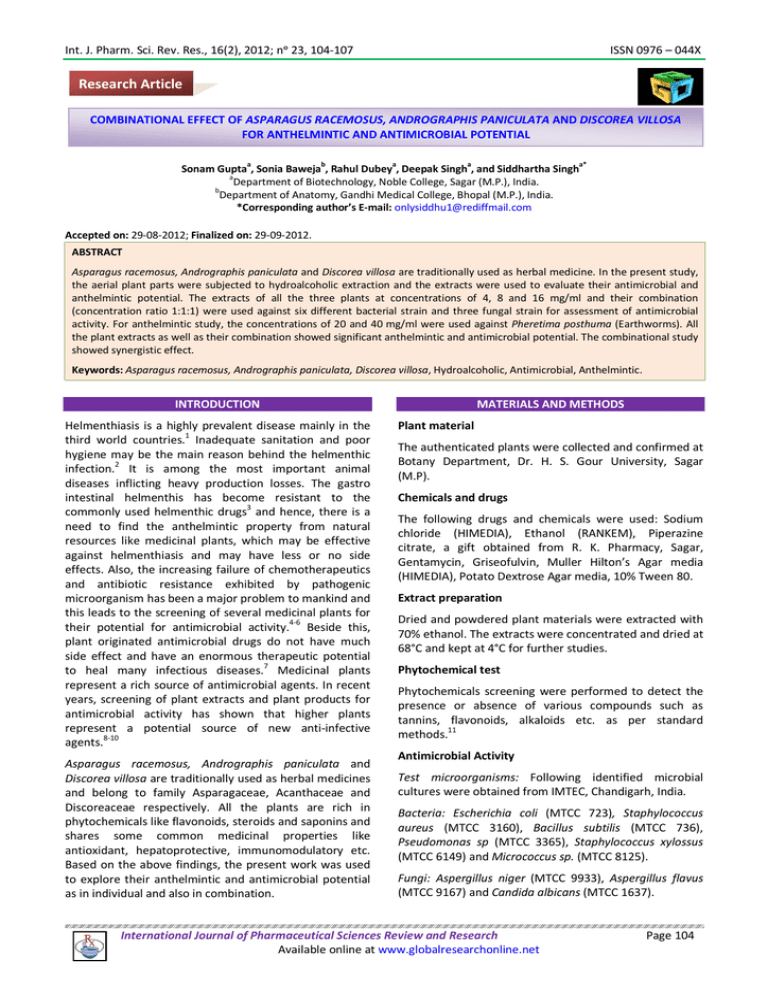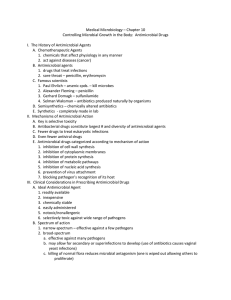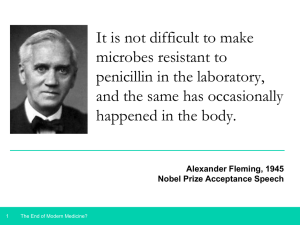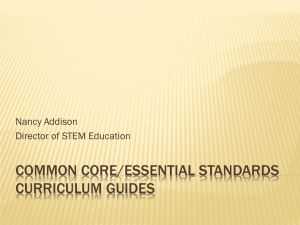Document 13308903
advertisement

Int. J. Pharm. Sci. Rev. Res., 16(2), 2012; nᵒ 23, 104-107 ISSN 0976 – 044X Research Article COMBINATIONAL EFFECT OF ASPARAGUS RACEMOSUS, ANDROGRAPHIS PANICULATA AND DISCOREA VILLOSA FOR ANTHELMINTIC AND ANTIMICROBIAL POTENTIAL a b a a a* Sonam Gupta , Sonia Baweja , Rahul Dubey , Deepak Singh , and Siddhartha Singh a Department of Biotechnology, Noble College, Sagar (M.P.), India. b Department of Anatomy, Gandhi Medical College, Bhopal (M.P.), India. *Corresponding author’s E-mail: onlysiddhu1@rediffmail.com Accepted on: 29-08-2012; Finalized on: 29-09-2012. ABSTRACT Asparagus racemosus, Andrographis paniculata and Discorea villosa are traditionally used as herbal medicine. In the present study, the aerial plant parts were subjected to hydroalcoholic extraction and the extracts were used to evaluate their antimicrobial and anthelmintic potential. The extracts of all the three plants at concentrations of 4, 8 and 16 mg/ml and their combination (concentration ratio 1:1:1) were used against six different bacterial strain and three fungal strain for assessment of antimicrobial activity. For anthelmintic study, the concentrations of 20 and 40 mg/ml were used against Pheretima posthuma (Earthworms). All the plant extracts as well as their combination showed significant anthelmintic and antimicrobial potential. The combinational study showed synergistic effect. Keywords: Asparagus racemosus, Andrographis paniculata, Discorea villosa, Hydroalcoholic, Antimicrobial, Anthelmintic. INTRODUCTION Helmenthiasis is a highly prevalent disease mainly in the third world countries.1 Inadequate sanitation and poor hygiene may be the main reason behind the helmenthic infection.2 It is among the most important animal diseases inflicting heavy production losses. The gastro intestinal helmenthis has become resistant to the commonly used helmenthic drugs3 and hence, there is a need to find the anthelmintic property from natural resources like medicinal plants, which may be effective against helmenthiasis and may have less or no side effects. Also, the increasing failure of chemotherapeutics and antibiotic resistance exhibited by pathogenic microorganism has been a major problem to mankind and this leads to the screening of several medicinal plants for their potential for antimicrobial activity.4-6 Beside this, plant originated antimicrobial drugs do not have much side effect and have an enormous therapeutic potential to heal many infectious diseases.7 Medicinal plants represent a rich source of antimicrobial agents. In recent years, screening of plant extracts and plant products for antimicrobial activity has shown that higher plants represent a potential source of new anti-infective agents.8-10 Asparagus racemosus, Andrographis paniculata and Discorea villosa are traditionally used as herbal medicines and belong to family Asparagaceae, Acanthaceae and Discoreaceae respectively. All the plants are rich in phytochemicals like flavonoids, steroids and saponins and shares some common medicinal properties like antioxidant, hepatoprotective, immunomodulatory etc. Based on the above findings, the present work was used to explore their anthelmintic and antimicrobial potential as in individual and also in combination. MATERIALS AND METHODS Plant material The authenticated plants were collected and confirmed at Botany Department, Dr. H. S. Gour University, Sagar (M.P). Chemicals and drugs The following drugs and chemicals were used: Sodium chloride (HIMEDIA), Ethanol (RANKEM), Piperazine citrate, a gift obtained from R. K. Pharmacy, Sagar, Gentamycin, Griseofulvin, Muller Hilton’s Agar media (HIMEDIA), Potato Dextrose Agar media, 10% Tween 80. Extract preparation Dried and powdered plant materials were extracted with 70% ethanol. The extracts were concentrated and dried at 68°C and kept at 4°C for further studies. Phytochemical test Phytochemicals screening were performed to detect the presence or absence of various compounds such as tannins, flavonoids, alkaloids etc. as per standard methods.11 Antimicrobial Activity Test microorganisms: Following identified microbial cultures were obtained from IMTEC, Chandigarh, India. Bacteria: Escherichia coli (MTCC 723), Staphylococcus aureus (MTCC 3160), Bacillus subtilis (MTCC 736), Pseudomonas sp (MTCC 3365), Staphylococcus xylossus (MTCC 6149) and Micrococcus sp. (MTCC 8125). Fungi: Aspergillus niger (MTCC 9933), Aspergillus flavus (MTCC 9167) and Candida albicans (MTCC 1637). International Journal of Pharmaceutical Sciences Review and Research Available online at www.globalresearchonline.net Page 104 Int. J. Pharm. Sci. Rev. Res., 16(2), 2012; nᵒ 23, 104-107 Table 1: Phytochemical analysis of hydroalcoholic extract of A. paniculata, A. racemosus and D. villosa extracts Phytochemical/Test A. paniculata A. racemosus D. villosa Alkaloids + + - Flavonoids + + + Tannins + - + Terpenoids + - + Steroids + + + Glycosides + - - Carbohydrates + + + Saponins + + + Cardiac glycoside + + + Phenolic compounds + - + Anthelmintic activity + : Present; ─ : Absent. Table 2: Antibacterial activity of A. paniculata, D. villosa and A. racemosus AP DV RESULTS In the present investigation, the phytochemical screening showed the presence of flavonoids, carbohydrate, cardiac glycosides, saponin and steroids in all the plant extracts. Apart from this, alkaloids were present only in the extract of Andrographis paniculata and Asparagus racemosus while, glycosides were present only in A. paniculata extract (table 1). For antimicrobial screening, AR Conc. (mg/ml) 4.0 8.0 16 4.0 8.0 16 4.0 8.0 16 P. stringii Extract Micrococcus sp. Zone of Inhibition (mm) S. xylossus Experiment: The experiments were carried out by the method described by Singh et al., 200915. All the three extracts were dissolved in normal saline and diluted to get final concentrations of 20 and 40 mg/ml. Piperazine citrate (20 mg/ml) was used as a standard drug. Nine groups, each containing six earthworms were taken for the experiment. Extracts and piperazine citrate were dissolved separately in their respective concentration in 10ml normal saline. For combinational study, the different extracts were taken in the concentration ratio of 1:1:1. Time taken for paralysis and death of individual earthworm was noted. The paralysis occurs when the worms were placed in normal saline and were not able to move. The death was confirmed when the earthworms lost their motility and fading off their body colors.16 B. subtilis Experimental model: The earthworms show physiological and anatomical resemblance with intestinal parasites and round worms14 and were used for the anthelmintic assay. Indian adult earthworms (Pheretima posthuma, 5-7cm in length) were freshly collected from organic farm of local earthworm breeding centre (N.H. 26, Sagar). S. aureus Similarly, for the antifungal activity13, the stock cultures of fungi were revived by inoculating in broth media and grown at 27ᵒC for 72 h. The agar plates of the Potato Dextrose Agar media were prepared. Each plate was inoculated with an aliquot (0.1 ml) of the fungal suspension (103 spores/ml), which was spread evenly on the plate. After 20 min, antimicrobial disc soaked with the respective extracts of different concentration were placed on the plates. The positive and negative control plates with Griseofulvin (standard drug) and 10% Tween 80 were also prepared. All the plates were incubated at 27ᵒC for 72 h and then the diameter of zone of inhibition was noted. hydroalcoholic extracts of A. paniculata, A. racemosus and D. villosa were tested against 6 bacterial and 3 fungal strains. The observations were compared with that of standard antibiotic drugs in terms of diameter of zone of inhibition. The combination of all three extracts was found most potent at a concentration of 16 mg/ml against E. coli (inhibition zone, 8 mm), S. xylossus (inhibition zone, 15 mm) and Micrococcus (inhibition zone, 15 mm). While, A. racemosus was found to be most effective against S. aureus and P. Stringii with 15 and 10 mm inhibition zone respectively. A. paniculata was most effective against B. Subtilis in comparison with all the three extracts. D. villosa was found to be most potent against C. albicans (9 mm zone of inhibition) while the combination was effective against A. flavus (6 mm zone of inhibition). A. paniculata showed moderate results against all three tested fungi (table 2 and 3). E. coli 12 Antimicrobial Assay: For antibacterial assay , initially the stock cultures of bacteria were revived by inoculating in broth media and grown at 37˚C for 18 h. The agar plates of the Muller Hilton’s Agar media were prepared. Each plate was inoculated with an aliquot (0.1 ml) of the bacterial suspension (105-106 colony forming unit “CFU”/ml), which was spread evenly on the plate. After 20 min, antimicrobial disc soaked with the respective extracts of different concentration were placed on the plates. The positive and negative control wells were filled with Gentamycin (Standard drug) and 10% Tween 80 respectively. All the plates were incubated at 37˚C for 24 h and then the diameter of zone of inhibition was noted. ISSN 0976 – 044X 3 5 6 3 3 4 3 3 3 3 4 4 2 1 5 15 5 6 6 3 4 - 3 4 5 8 10 14 3 3 4 3 3 4 4 4 5 3 3 5 10 AP+DV+AR 16 8 9 4 15 15 4 (1:1:1) Gentamycin (Standard 1.0 19 20 28 18 18 18 drug) AP = Andrographis paniculata; DV = Discorea villosa; AR = Asparagus racemosus; - = No zone of inhibition International Journal of Pharmaceutical Sciences Review and Research Available online at www.globalresearchonline.net Page 105 Int. J. Pharm. Sci. Rev. Res., 16(2), 2012; nᵒ 23, 104-107 Table 3: Antifungal activity of A. paniculata, D. villosa and A. racemosus DV AR AP+DV+AR (1:1:1) Griseofulvin (Standard drug) C. albicans AP Concentration (mg/ml) A. flavus Extract A. niger Zone of Inhibition (mm) 4.0 8.0 16 4.0 8.0 16 4.0 8.0 16 3 3 4 4 4 5 3 3 4 3 4 4 4 5 5 3 3 4 4 4 5 3 4 9 3 3 4 16 - 6 8 1.0 13 18 13 AP = Andrographis paniculata; DV = Discorea villosa; AR = Asparagus racemosus; - = No zone of inhibition All the three plants analyzed for their anthelmintic potential showed a concentration depended activity. A. paniculata extract showed better activity by way of causing the paralysis of the worms at 3.33 min at 40 mg/ml and 5.33 min at 20 mg/ml and death in 5.16 min at 40 mg/ml and 7.50 min at 20 mg/ml. Combination of all three extracts (1:1:1) was found most potent and caused paralysis of the worm at 2.83 min and death at 4.33 min. The time taken by the standard drug (20 mg/ml) for the paralysis and death of the worms was 7.0 and 14.83 min respectively. The combination showed synergistic effect for anthelmintic activity (Table 4). Table 4: Anthelmintic activity of A. paniculata, D. villosa and A. racemosus Extract/Drug AP DV AR AP+DV+AR (1:1:1) Piperazine citrate Normal Saline (Control) Concentration (mg/ml) Paralysis time ISSN 0976 – 044X interference with nucleic acid synthesis, and inhibition of a metabolic pathway.17-19 The most selective antimicrobial agents are those that interfere with the synthesis of bacterial cell walls e.g. penicillin, cephalosporin etc. these drugs have high therapeutic index because bacterial cell walls possess a unique structure, not found in eukaryotic cells. All three extracts may possess the similar mechanisms of action against the microbes. Synthetic anthelmintic drugs like piperazine citrate, is known to cause paralysis of worms so that they are expelled in the feaces of men and animals. The extracts in the present study could cause paralysis as well as the death of the worms. These drugs may reach the target site in worms either orally or by diffusion and/or uptake through the cuticle, however the major uptake of the 20 drug is through cuticle. All the three extracts when taken in combination, generally showed synergistically better activity as compared to individual effect. The variation in activity of the plant extract might be due to the difference in the proportion of the active compounds responsible for the anthelmintic property.21 The active constituents may be the phenolics such as flavonoids and tannins present in the plant extracts. CONCLUSION As the search for new antimicrobial and anthelmintic agent is in demand, plant extracts may provide attractive alternate sources of antimicrobial and anthelmintic drug against various microbial and helminthes diseases. The present study provides the evidence of antimicrobial and anthelmintic property of A. paniculata, A. racemosus and D. villosa. Also, the synergistic effect shown by the plant extracts when taken in combination gave a better idea of working on a polyherbal combination which may give better result as compared to individual effect. REFERENCES Death time Min. 20 5.33 ± 0.40 7.50 ± 0.20 40 20 40 20 40 40 20 3.33 ± 0.18 10.23 ± 0.23 4.83 ± 0.14 12 ± 0.23 5.83 ± 0.14 2.83 ± 0.14 7 ± 0.33 5.16 ± 0.14 15.16 ± 0.43 6.50 ± 0.31 16.50 ± 0.20 7.33 ± 0.18 4.33 ± 0.18 14.83 ± 0.36 - - - 1. Dhar DN, Sharma RL, Bansal GC, Gastrointestinal nematodes in sheep in Kashmir, Vet. Parasitol, 11, 1982, 271–7. 2. Chan MS, The global burden of intestinal nematode infections, Fifty years on Parasitol Today, 13, 1997, 438–43. 3. Geert S, Dorny P, Anthelmintic resistance in helminthes of animals of man in the tropics, Bulletin-des-Seances, Academic Royale des Sciencesd, Dutre Mer, 3, 1995, 401– 23. 4. Elizabeth KM, Antimicrobial activity of Terminalia bellerica, Indian Journal of Clinical Biochemistry, 20 (2), 2005, 150153. 5. Ritch-Kro EM, Turner NJ, Towers GH, Carrier herbal medicine: an evaluation of the antimicrobial and anti cancer activity in some frequently used remedies. Journal of Ethnopharmacology, 5, 1996, 151-156. 6. Colombo ML, Bosisio E, Pharmacological activities of Chelidonium majus L (Papaveraceae), Pharmacol Res., 33, 127-134. DISCUSSION In the present investigation, all the extracts and their combination showed activity against some bacteria and fungi. This activity is mainly due to the presence of phytochemicals like tannins, flavonoids, alkaloids and glycosides. Tannins and flavonoids were known to possess antimicrobial potential against bacteria and fungi. Antimicrobial agents can damage pathogens in several ways. The major modes of actions are interference with cell wall synthesis, inhibition of protein synthesis, International Journal of Pharmaceutical Sciences Review and Research Available online at www.globalresearchonline.net Page 106 Int. J. Pharm. Sci. Rev. Res., 16(2), 2012; nᵒ 23, 104-107 ISSN 0976 – 044X 7. Iwu MW, Duncan AR, Okunji CO, New antimicrobials of plant origin. In: Janick J. (ed.): Perspectives on New Crops and New Uses. ASHS Press, Alexandria VA.1999; 457–462. 15. Singh S, Mehta A, John J, Mehta P, Anthelmintic Potential of Andrographis paniculata, Cajanus cajan and Silybum marianum PHCOG J, 1 (4), 2011, 243‐245. 8. Amani S, Isla MI, Vattuone M, Poch M, Cudmani N, Sampietro A, Antimicrobial activities in some Argentine medicinal plants, Acta Horticulturae, 501, 1998, 115–122. 9. Salvat A, Antonnacci L, Fortunato RH, Suarez EY, Godoy HM, Screening of some plants from Northern Argentina for their antimicrobial activity, Letters in Applied Microbiology, 32, 2001, 293– 297. 16. Girme AS, Bhalke RD, Ghogare PB, Tambe VD, Jadhav RS, Nirmal SA, Comparative In vitro Anthelmintic Activity of Mentha piperita and Lantana camara from Western India, Dhaka University Journal of Pharmaceutical Sciences, 5(1– 2), 2006, 5–7. 10. Arias ME, Gomez, JD, Cudmani N, Vattuone MA, Isla MI, Antibacterial activity of ethanolic and aqueous extract of Acacia aroma, Life Science, 5, 2004, 191–202. 11. Manjunath KP, Kulkarni GT, Patil KS, Preliminary Phytochemical investigation and wound healing activity of the root of Swertia chirata Buch. Ham. (gentianaceae), Indian Drugs, 43, 2006, 535–537. 12. Selvamani P, Latha S, Antimicrobial activity of crude extracts of Cassia alata, Indian J Nat Prod., 20, 2004, 30-32. 13. Zhu XF, Zhang HX, Lo R, Antifungal activity of Cynara scolymus L. extracts, Fitoterapia, 76, 2005,108-111. 14. Nirmal SA, Malwadkar G, Laware RB, Anthelmintic activity of Pongamia glabra. Songklanakarin Journal of Science and Technology, 29(3), 2007, 755–757. 17. Haslam E, Natural polyphenols (vegetable tannins) as drugs: possible mode of action, J Nat Prod, 59, 1996, 205215. 18. Scalbert A, Antimicrobial properties Phytochemistry, 30, 1991, 3875-3883. of tannins, 19. Dixon RA, Dey PM, Lamb CJ, Phytoalexins: enzymology and molecular biology, Adv enzymol, 55, 1983, 1-69. 20. Geary TG, Sangster NC, Thompson DP, Frontiers in anthelmintic pharmacology. Vet Parasitol, 84, 1999, 275– 295. 21. Eguale T, Thilahun G, Gidey M, Mekonnen Y, In vitro anthelmintic activities of four Ethiopion medicinal plants against Haemonchus contortus, Pharmacologyonldine, 3, 2006, 153–165. ********************** International Journal of Pharmaceutical Sciences Review and Research Available online at www.globalresearchonline.net Page 107






